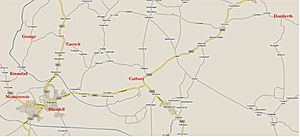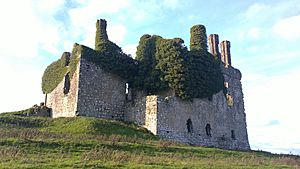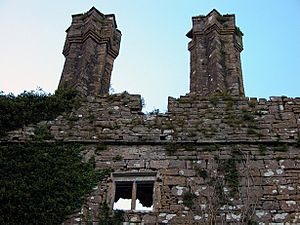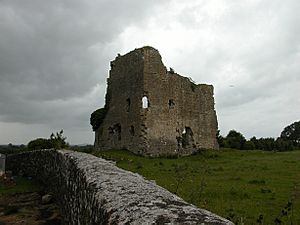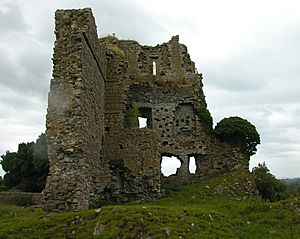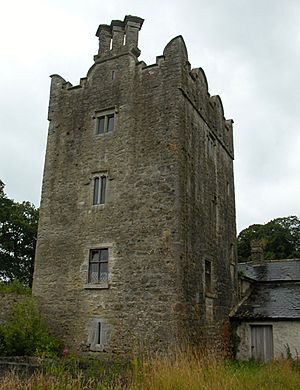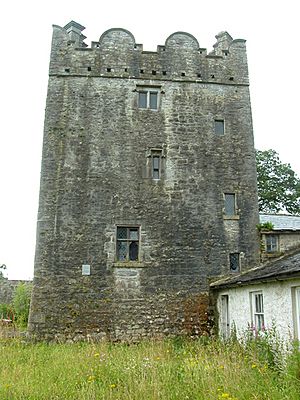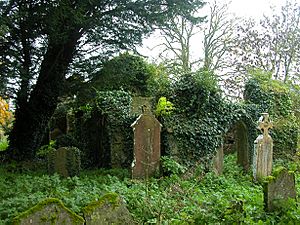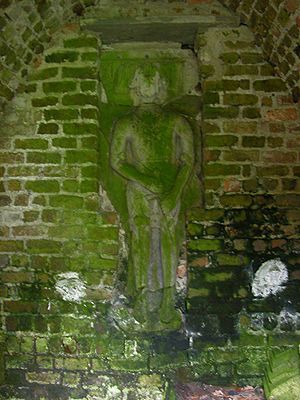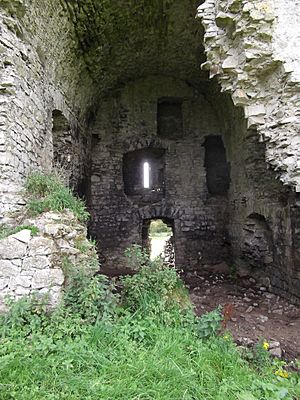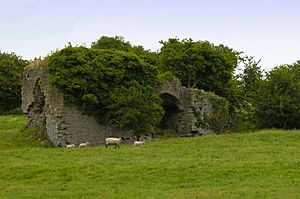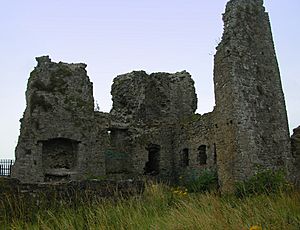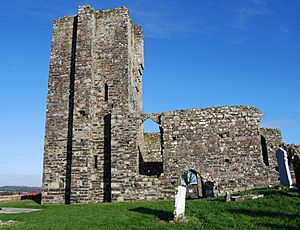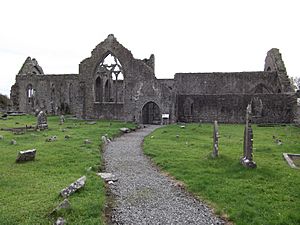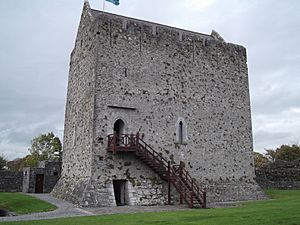Bermingham Castles of Ireland facts for kids
The Bermingham family left many old buildings in Ireland. You can find these monuments mostly in Kildare, Offaly, Galway, and Dublin. Many of these old places are now ruins. However, Athenry Castle in Galway has been fixed up. It was repaired using the same building methods from long ago.
In Kildare and Offaly, there are five castles and one monastery still standing. These include Carbury Castle, Grange Castle, and Carrick Castle in County Kildare. In County Offaly, you'll find Blundell Castle, Kinnefad Castle, and Monasteroris Monastery. County Galway has Athenry Castle and Monastery, plus Dunmore Castle.
Contents
- Carbury Castle: A Hilltop Ruin
- Carrick Castle: A Tall Tower
- Grange Castle: A Changing Home
- Dunfierth Church: A Family Chapel
- Kinnefad Castle: A Stronghold by the Ford
- Monasteroris Monastery: A Friary's Story
- Blundell Castle: Overlooking Edenderry
- Baldungan Church: A View of the Sea
- Athenry Castle and Priory: A Medieval Hub
- Dunmore Castle: The Big Fort
Carbury Castle: A Hilltop Ruin
Carbury Castle stands on Carbury Hill, sometimes called Fairy Hill. This hill is on the border of Kildare and Offaly. The castle was once a grand Tudor mansion. It was first built as a small fort by Meiler FitzHenry. Later, the Bermingham family owned it in the 1300s. In the 1500s, the Colley family took over. They were ancestors of the famous Duke of Wellington. The Colleys built a strong house here in the 1600s.
Carrick Castle: A Tall Tower
Carrick Castle is about three miles from Edenderry town. It's a tall, square tower. When it was new, it was very long and wide. Sir Pierce Bermingham built this castle in the 1200s. The castle's high position, like Carbury, made it a great place for defense. Sadly, much of it is now in ruins. Only two main walls remain. But you can still see some cool details, like the old windows and chimneys. Next to Carrick Castle, there's an old church and graveyard.
Grange Castle: A Changing Home
Grange Castle is close to Carrick Castle. The Bermingham family built this tower house in the late 1400s. In the early 1600s, fancy chimneys and battlements were added. Battlements are the parts of a castle wall with gaps for defense. In 1735, Walter Bermingham sold Grange. It stayed with the Tyrrell family until 1988.
Over the years, different owners changed Grange Castle. A large hall, now called Fallon Hall, has been restored. There's also a walled garden and old farm buildings. Even though the grounds are now wild, Grange Castle is a beautiful example of old architecture.
Dunfierth Church: A Family Chapel
The old Dunfierth Church is near Johnstown Bridge in Kildare. The church ruins are surrounded by a large graveyard. Inside, there's a special chapel for the Bermingham family.
A detailed stone tomb used to be in the middle of this chapel. Now, parts of it are built into the walls. A stone statue, called an effigy, stands upright in the chapel. It shows a knight in armor with a cross on his chest. This statue is probably of Sir William Bermingham.
Kinnefad Castle: A Stronghold by the Ford
Kinnefad Castle is just outside Edenderry. Its name means "the head of the ford," which is a shallow river crossing. This was another strong castle of the Bermingham family from the 1300s. The eastern wall is gone, so you can see inside. You can even spot a few flagstones from an old spiral staircase.
An old writer named Wilde described Kinnefad. He said it was a large, square building. Its few, narrow windows show it was built for strength, not comfort. Local stories say the shallow river nearby was often a place of fierce fights. Old weapons have been found near the castle, like axes and spearheads.
Monasteroris Monastery: A Friary's Story
Monasteroris Monastery is on farmland, like many Bermingham castles. Not much of it remains today, and ivy covers most of the ruins. The name Monasteroris comes from Irish, meaning "the monastery of the son of Feorais." John de Bermingham, who was an Earl, built this monastery for friars in 1325.
The O'Connors, an old Irish family, used the friary as a fort. The building was badly damaged in a battle in 1521. But the friars stayed in the area for another 50 years. They returned around 1645. After the friars left during Cromwell's time, there was little sign of them. Later, in the 1700s, friars returned to help local parishes.
Blundell Castle: Overlooking Edenderry
Blundell Castle sits on a hill above Edenderry town. It was built by the De Berminghams in the 1400s. In the 1500s, the Colley family owned it. Because of them, Edenderry was sometimes called Coolestown or Colleytown. Sir George Colley defended the castle in 1599 during a war. In 1691, an army attacked the castle. It has been a ruin ever since.
Local people in Edenderry talk about a secret tunnel near Blundell Castle. They say it connects Blundell to Carbury Castle, which is about five miles away. If this tunnel really exists, the Berminghams might have built it. It could have been a way to communicate during conflicts.
Baldungan Church: A View of the Sea
About two miles from Lusk are the ruins of Baldungan Church. It offers amazing views of the countryside and the sea. The Barnewall family likely built this church in the late 1200s. It then passed to the De Berminghams through marriage. Later, it went to the St. Laurence family, possibly when Lady Elizabeth Bermingham married Christopher St. Laurence.
Athenry Castle and Priory: A Medieval Hub
Meiler de Bermingham built Athenry Monastery in 1241. He spent a lot of money and asked other nobles to help build it. He also gave gifts like wine, cloth, and horses to move stones. Once finished, he gave the monastery to the Dominican friars. He also gave them more money to build an abbey. Athenry Castle is also believed to have been built by Meiler de Bermingham. It stands on an old man-made hill.
Meiler likely received land in Athenry directly from Richard de Burgh. King Henry III also gave Meiler permission to hold a market and a fair in Athenry in 1244. This helped Athenry become an important place for trade.
Dunmore Castle: The Big Fort
Dunmore Castle gets its name from the Irish "an Dún Mór," meaning "the big fort." Dunmore Castle is a strong tower built by Meiler de Bermingham around 1225. It was attacked and burned by Irish forces several times in the 1200s and 1300s. In the early 1300s, a second floor was added. In the 1500s, a sloped roof, fireplaces, and chimneys were put in.
The De Bermingham family owned the castle until the time of Cromwell. People lived in it until the 1800s.


